
Navigate this page
| Family Recipe Book | Famous Morrisons | Family Tales |
|---|
Send your favorite recipes for publication.
Most Interesting school sandwiches:
Velveeta cheese, sliced sweet pickles, with mayo (Morrisons only eat Hellmans) on white
Peanut butter, pickle relish, mayo on white
Recipe from "Cooking with Dorothy"
Battle Stations Popcorn
1. Plug in popcorn maker
2. Pour in oil
3. Pour in popcorn
4. Put on glass cover
5. In separate pan on stove - melt butter
6. Wait impatiently
7. When condensation clouds glass cover - kids get ready and put heads over popcorn maker and get excited
8. When first popcorn seed pops, all kids yell "Battle Stations!!"
a. one kid mans the plug (Patty)
b. second kid gets bowl ready and pours completed popcorn in (Jim)
c. third kid gets butter and puts on corn (Dave)
d. if there is a fourth kid, serves as understudy (Bill)
9. Eat popcorn
10. Mom cleans up
Cookbook Contents
Click here for the recipes included in "Cooking with Dorothy"
Cooking with Dorothy
Look here for the cookbook and some funny memories of six kids in the family household of Dorothy and Keith Morrison. Additions or corrections welcome.
Jim Morrison of the Doors
John Wayne aka Marion Morrison

Navigate Famous Morrisons
American rock singer and rock lyric who achieved after his death a cult position among fans. Morrison wished to be accepted as a serious artist, and he published such collections of poetry as An American Prayer (1970) and The Lords and The New Creatures (1971). The song lyrics Morrison wrote for The Doors much reflected the tensions of the time - drug culture, the antiwar movement, avant-garde art. With his early death Morrison has been seen as a voluntary victim of the destructive forces in pop culture. However, he was not ignorat about the consequences of fame and his position as an idol. Morrison once confessed that "We're more interested in the dark side of life, the evil thing, the night time."
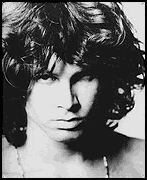
"This is the end, beautiful friend.
It hurts to set you free,
But you'll never follow me.
The end of laughter and soft lies.
The end of nights we tried to die.
This is the... end."
James Douglas Morrison was born in Melbourne, Florida, on December 8, 1943. His father, Steve Morrison, was a U.S. Navy admiral. In 1942, after graduating from the Naval Academy, he had married Clara (Clarke) Morrison, the daughter of a lawyer. In 1946 he returned from the Pacific and during the following years the family moved according to his numerous postings.
Morrison was early interested in literature, he excelled at school, and he had an IQ of 149. Morrison studied theatre arts at the University of California. With his fellow student Ray Manzarek, keyboardist, John Densmore, drummer, and Robbie Kriger, guitarist, he formed a group which was in 1965 christened The Doors. They never added a bass player to their group. Its name was taken from Aldous Huxley's book on mescaline, The Doors of Perception, which quoted William Blake's poem ("If the doors of perception were cleansed / All things would appear infinite"). All the members of the band read much, not only Morrison. Their first album, The Doors (1967), mixed performances from Bertolt Brecht/Kurt Weil's 'Alabama Song (Whisky Bar)' to Willie Dixon's 'Back Door Man'. It also included such Doors classics as 'Break on Through' (to the Other Side)' and 'The End'. The lyrics Morrison wrote in 1965 dominated the first two Doors albums. In July 1967 the band had its first single chart success with 'Light My Fire'.
 Between childhood, boyhood,
-------------adolescence
& manhood (maturity) there
should be sharp lines drawn w/
Tests, deaths, feasts, rites
stories, songs & judgements
(from Wilderness, 1988)
Between childhood, boyhood,
-------------adolescence
& manhood (maturity) there
should be sharp lines drawn w/
Tests, deaths, feasts, rites
stories, songs & judgements
(from Wilderness, 1988)
Like in the late 1950s when the beatniks tried to unite jazz and poetry, Morrison found from music a channel to project his poetry, and add to it a theatrical aspect. Thus improvising and unpredictableness was a part of the band's show on stage. The mythical Lizard King, Morrison's alter ego, appeared first in the best-selling record Waiting for the Sun (1968) in a poem that was printed inside the record jacked. I was entitled 'The Celebration of the Lizard King'. Part of the lyrics were used in 'Not to Touch the Earth' and the complete 'Celebration' appeared on record Absolutely Live (1970).
Morrison's drinking, exhibitionistic performances, and drug-taking badly affected his singing and input at recordings. "Let's just say I was testing the bounds of reality," he confessed in 1969 in Los Angeles. "I was curious to see what would happen. That's all it was: just curiosity." In Miami in 1969 the audience thought it saw Jim's "snake" - he was charged with exposing himself on stage, in full view of 10.000 people. The police did not arrest him on the spot, for fear that it would cause a riot. Next year Morrison was sentenced 8 months' hard labor and a $500 fine for "profanity" and "indecent exposure", but he remained free while the sentence was appealed against. The Soft Parade (1969), which experimented with brass sections, was received with mixed emotions but it had a hit single, 'Touch me'.
After Miami everything changed and Morrison put his leather pants in closet. He grew a beard, started to take distance to his fans, and devote more time with projects outside the band. John Densmore has later told in an interview, that although he knew Jim well, there was so much about him that he could not find out. Possessed by his inner visions and urge to write and create music, Morrison also had troubles to explain his aims. He also felt that his time was running short: "O great creator of being, grant us one more hour / to perform our art and perfect our lives."
In April 1970 Morrison Hotel hit the lists in the U.S. and England. It was hailed as a major comeback. One song on it, 'Queen of the Highway', was dedicated Pamela Courson, his common-law wife, who called herself Pamela Morrison. Jim called Pamela his "cosmic mate". Morrison had also an affair with Linda Ashcroft from 1967 to 1971. With Patricia Kennealy, a rock critic, he had romance which started in 1969; supposedly they were joined in a Wiccan ceromony, known as a Handfasting. Morrison did not take the ritual seriously.
On his 27th birthday, Morrison made the recordings at Elektra's LA studio of his poetry, which later formed the basis of An American Prayer. The Doors played their last concert with Morrison in New Orleans. It was a disaster - Morrison smashed the microphone into the stage, threw the stand into the crowd and slumped down.
After finishing sessions for a new album, L.A. Woman, Morrison escaped to Paris, where he hoped to follow literary career. "See me change," he sang. He never came back from Paris. His first book, The Lords and the New Creatures, was published by Simon and Schuster in 1971. It went into paperback after selling 15.000 in hardback. An earlier book, An American Prayer, was privately printed in 1970, but not made widely available until 1978. On 3 July 1971 Morrison was found death in his bathtub. He had regurgitated a small amount of blood on the night of July 2, but claimed he felt fine. Recently had consulted a local doctor concerning a respitory problem.
Morrison was buried at Pére Lachaise cemetary in Paris, which houses remains of many famous artists, statesmen and legendaries from Edith Piaf to Oscar Wilde. In 1990 his graffitti-covered headstone was stolen. Pamela Courson Morrison, died in Hollywood of heroin overdose on April 25, 1974. In 1979 Francis Ford Coppola used The Doors' performance of 'The End' in his Vietnam War film, Apocalypse Now, and in 1991 director Oliver Stone made the film biography The Doors, starring Val Kilmer. Wilderness: The Lost Writings of Jim Morrison was published in 1989. It was compiled from the Morrison literary estate by his friends.
Notes on life:
Name: James "Jim" Douglas MORRISON
Birth: 8 DEC 1943 in Melbourne, Brevard Co., FL
Note: death certificate states Clearwater, FL
Residence: 1947 New Mexico
Residence: 1948 Mountain View, Santa Clara Co., CA
Note: 476 Yosemite Ave, attended Highway School at Calderon & El Camino Real
Residence: 1958 Alexandria, Fairfax Co., VA
EDU: JAN 1959 Alexandria, Fairfax Co., VA
Note: attended George Washington High School
GRAD: 1961 Alexandria, Fairfax Co., VA
Note: George Washington High School
Residence: AUG 1961 Saint Petersburg, Pinellas Co., FL
Note: Saint Petersburg Junior College
Residence: 1962 Tallahassee, Leon Co., FL
Note: Florida State Universiy
Residence: 1964 Los Angeles, Los Angeles Co., CA
Note: UCLA
GRAD: 1965 Los Angeles, Los Angeles Co., CA
Note: UCLA
MEDI: 12 FEB 1969 Beverly Hills, Los Angeles Co., CA
Note: signed last will and testament
Residence: MAR 1971 Los Angeles, Los Angeles Co., CA
Note: 8216 Morton Avenue
Death: 3 JUL 1971 in Paris, France
Burial: Cimetière du Père Lachaise, Paris, France
Note: in Poet's Corner
Occupation: poet, singer, songwriter for The Doors
Cause: heart attack
Born Marion Morrison,  film legend John Wayne was a member of the Sigma Chi fraternity and played on the USC football team. Western movie star Tom Mix gave him a summer job working as a prop boy in exchange for football tickets. On the set, Morrison met John Ford (who later directed him in "Stagecoach" and "The Searchers" among others) and changed his name to John Wayne in 1930, and the rest, as they say, is history. The revered actor and director was received two Academy Awards nominations for best actor and won in 1969 for his portrayal of Rooster Cogburn in the immortal western "True Grit." Wayne never graduated from USC.
film legend John Wayne was a member of the Sigma Chi fraternity and played on the USC football team. Western movie star Tom Mix gave him a summer job working as a prop boy in exchange for football tickets. On the set, Morrison met John Ford (who later directed him in "Stagecoach" and "The Searchers" among others) and changed his name to John Wayne in 1930, and the rest, as they say, is history. The revered actor and director was received two Academy Awards nominations for best actor and won in 1969 for his portrayal of Rooster Cogburn in the immortal western "True Grit." Wayne never graduated from USC.
John Wayne Genealogy
DUKE'S SILENT MOVIES
1925 - 1929
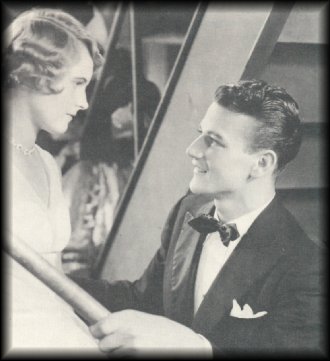 Marion Morrison, during his Senior year of high school, played football on a team that went undefeated. He won a football scholarship to USC, but it was still necessary for him to pick up part-time work. His football coach got him a summer job as a prop man and set-dresser at the William Fox Film Studio (today's 20th Century Fox). Eventually, John Ford, the director, started using Marion Morrison, known as Duke, as a bit player, and Duke's career was on its way, and eventually he would be known world-wide as John Wayne. The nine silent films he worked on can be found at the web site above and are but a few of the films Duke worked on or in from 1925 and into 1929, but these are all that are presently known.
Marion Morrison, during his Senior year of high school, played football on a team that went undefeated. He won a football scholarship to USC, but it was still necessary for him to pick up part-time work. His football coach got him a summer job as a prop man and set-dresser at the William Fox Film Studio (today's 20th Century Fox). Eventually, John Ford, the director, started using Marion Morrison, known as Duke, as a bit player, and Duke's career was on its way, and eventually he would be known world-wide as John Wayne. The nine silent films he worked on can be found at the web site above and are but a few of the films Duke worked on or in from 1925 and into 1929, but these are all that are presently known.

TRUE GRIT
1969 - Paramount
Main Cast: John Wayne, Kim Darby, Glen Campbell, Robert Duvall, Jeff Corey. Directed by Henry Hathaway.
John is Rooster Cogburn, an ex-outlaw, who is a federal marshal in the Indian territory. He is hired by Kim Darby to go after the murderer of her father. Duke's performance as the crusty, one-eyed Rooster Cogburn was in many ways equal to his Ethan Edwards role in The Searchers. John Wayne was nominated and finally won an Oscar for his acting in this picture.
Fred Morrison Bagpiper
For an interesting history of bagpipes, check out this website suggested by Zoe Loomis who is interested in Scottish dance as well. Thanks, Zoe! A History of Bagpipes
AS SCOTTISH piping moves into the 21st century, Fred Morrison has carved himself an international reputation with a powerfully exuberant, highly improvisational style which combines the Gaelic piping tradition of the Uists with contemporary and eclectic influences. One of the few pipers to achieved success in both the competitive piping and folk music
scenes, Fred is a master of the Highland pipes and the bellows-blown Lowland or Border pipes, as well as playing Irish uillean pipes and low whistle.
 "...the nearest thing to jazz
you'll hear in Scottish piping"
"...the nearest thing to jazz
you'll hear in Scottish piping"
His playing has been described by Jim Gilchrist of The Scotsman as "the nearest thing to jazz you'll hear in Scottish piping", while Michael Grey, in Piper and Drummer Magazine , commented simply: "Fred Morrison's music astounds", and "Go and be gobsmacked," was the reaction from Rob Adams of The Herald.
"The King of the Pipes", as he is known in European piping enclaves, was born in 1963 near Bishopton, Renfrewshire, where he grew up, regularly visiting his paternal family home in Gerinish, South Uist. Taught piping by his late father - also Fred, also a notable piper - from the age of nine, Fred Junr became immersed in the rounded-out, driving piping style of the Outer Hebrides.
His father taught him through the traditional method of canntaireachd, the sung vocables used to convey pipe music before notation came on the scene, and Fred attributes much of his approach to that. "I hear that singing in my head every time I play," he told one interviewer.
Following a spell busking in the Netherlands, Fred trained as a primary school teacher then spent some time as a piping teacher in Glasgow schools a before a musical career beckoned. His prowess on the great Highland pipe had already gained him honours in the exacting Scottish competition piping circuit, including the coveted gold medals at Oban and Inverness, while he has taken the prestigious Macallan trophy at Brittany's Lorient Celtic Festival no less than seven times.
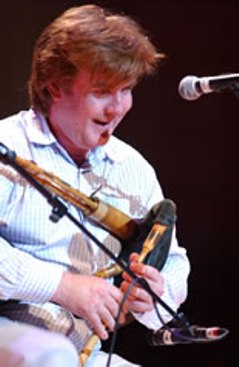 At a time when Scottish piping was broadening out into the burgeoning traditional music scene, Fred was experimenting, taking on board eclectic influences from elsewhere and developing a formidable technique that can put a unique spin on some of the most well-worn items in the repertoire.
At a time when Scottish piping was broadening out into the burgeoning traditional music scene, Fred was experimenting, taking on board eclectic influences from elsewhere and developing a formidable technique that can put a unique spin on some of the most well-worn items in the repertoire.
"Go and be gobsmacked.”
He was soon in demand as a solo performing artist, initially supporting the likes of Runrig and Capercaillie, before joining the short-lived "supergroup" Clan Alba (with Dick Gaughan, among others) then joining Capercaillie for three years, during which time he played in and helped arrange the Highland group's music for the film Rob Roy.
As his reputation spread, he took to the bellows-blown Scottish Lowland or Border bagpipes, which have been experiencing a revival in recent years and are more easily compatible with fiddles and other instruments than the Highland pipe, while their reeding is conducive to the kind of cross-fingering and vibrato which Fred employs in his playing. An enthusiastic fan of the great Paddy Keenan, piper with Ireland's legendary Bothy Band, he also added the Irish Uillean pipes and low whistle to his armoury.
While he still regards the Highland pipe as his first instrument, these days his concert performances tend to focus round the Border pipes, with interludes on uillean pipes and a mellifluous whistle. A recent fruitful partnership has been with bouzouki player Jamie McMenemy, a founder-member of the Battlefield Band and the Breton group Kornog, which can be heard on the most recent of Fred's three albums, Up South.
As well as cropping up on albums by numerous leading scottish musicians and singers, Fred's recent activities have included the Gaelic group Ceolas, of which he is a founder member, while his stature as a musician was recognised by Glasgow's mammoth Celtic Connections festival in January 2005, when he was commissioned to write the customary grand opening composition,. He called it Paracas, an ambitious musical journey through Gaelic culture and history which involved not only several pipers but other folk musicians and singers, as well as an orchestra and chorus.
"...voted Instrumentalist of the Year in
the Scots Trad Music Awards for 2004"
Another honour which Fred particularly cherished was being voted Instrumentalist of the Year in the Scots Trad Music Awards for 2004, which he welcomed as a recognition of piping as a popular art form, rather than as a personal accolade.
A recent extra-curricular activity has been his involvement with McCallum Bagpipes in lending his name and playing experience in developing a bellows blown pipe called the Fred Morrison reelpipes - "reel pipes" being the old Highland equivalent of the Border bagpipe - which have attracted much interest among pipers (for details see Carnan Music).
Fred lives with his musician wife Deirdre and their young family on the island of Benbecula, in the Uists - the very heartland of his music.
Free E-Book: "An Australian in China" by G.E.Morrison
GEORGE ERNEST MORRISON (1862-1920), British traveller and journalist, Peking correspondent of The Times from 1897 until 1912, when he resigned to become political adviser to Yuan Shih-k'ai, president of the newly proclaimed Chinese republic, was born at Geelong, Victoria, Australia. He displayed early in life a love of adventurous wandering and an insatiable curiosity concerning every phase and aspect of human affairs. Until his service with The Times obliged him to establish his headquarters at Peking, which he came in time to regard as his home, his career was an unbroken series of journeys, in which his love of adventure on unbeaten tracks was usually combined with some practical purpose of exploration.
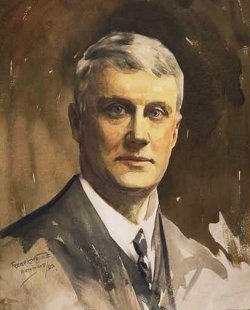
Thus, in 1882, he studied the Kanaka labour question in the South Sea Islands as a sailor before the mast. Later in the same year he crossed Australia on foot, from the Gulf of Carpentaria to Melbourne, covering 2,043 m. in 123 days. His next journey, to New Guinea, nearly cost him his life; he returned from it with two spear-heads in his body, which were eventually removed by Professor Cheyne at Edinburgh, under whom Morrison concluded his medical studies. In 1887 he took his M.D. and C.M. degrees, but the life of a medical practitioner had no attractions for him. After journeys to the United States and the West Indies he worked for a time in his medical capacity, first at the Rio Tinto mines in Spain and then as court physician to the shereef of Wazan in Morocco. From 1890-2 he was in charge of the hospital at Ballarat.
In 1893, wearying of routine work, he set out to travel in the Far East; in the following year he made a journey overland from Shanghai to Rangoon, and described it in a work entitled An Australian in China (1895). This journey laid the foundation of his reputation and led to the engagement of his services by The Times. In Nov. 1895 he went as special Times correspondent to Siam, where the French Government's claims in the region of the Mekong valley had necessitated negotiations for an agreement with Great Britain. Here he did excellent work; in Feb. 1897 he accepted the appointment offered him by The Times as resident correspondent at Peking, and for the rest of his life all his work and interests became centred in China.
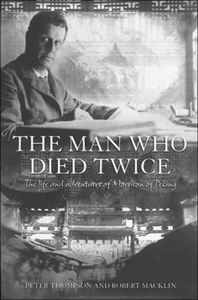
He never attained to any degree of p roficiency in the Chinese language, but in the course of numerous journeys during the ensuing 20 years he visited every province and dependency of the Empire, with the exception of Tibet, and Acquired an intimate knowledge of men and affairs in every part of the country. In 1907 he travelled from Peking to the borders of Tonquin, and three years later from Central China to Russian Turkestan. During the siege of Peking legations by the Boxers in 1900 he displayed conspicuous gallantry and initiative, and was specially mentioned in despatches by Sir Claude Macdonald. In Jan. 1905 he was present at the triumphal entry of the Japanese army into Port Arthur, and subsequently represented The Times at the Peace Conference which resulted in the Treaty of Portsmouth.
At the outset of the revolutionary movement in China (Oct. 1911) Dr. Morrison frankly proclaimed his sympathy with the Republican programme of Sun Yat-sen and the Cantonese Radicals, and advocated the abdication of the Manchu dynasty. In Aug. 1912, six months after the abdication, he became one of several foreign advisers engaged by the Chinese Government, with special duties as political adviser to President Yuan. When, during the stormy period between 191 3 and 1916, it became evident that Yuan Shih-k'ai intended to restore the monarchy in his own person, there were occasions when Dr. Morrison's position was somewhat delicate, because of the prominent part which he had played as an advocate of Republicanism, but his unfailing tact and good humour, com bined with his unquestionable devotion to the best interests of China, enabled him to fill this difficult position and to retain the goodwill and respect even of those who differed from his political opinions. For nearly 20 years his modernized Chinese house, with its famous library of works on China, was a place of pilgrimage for travellers in the Far East, and " Morrison of Peking " was a name familiar in all parts of the world. He died at Sidmouth May 30 1920.
James Morrison of the Bounty
Boatswain's MateMutineer, age 27
He was 5 feet 8 inches tall, with sallow complexion, long black hair, and a slender build. He had lost the upper joint of the forefinger of the right hand. He was tattooed with a star on his left breast, and a garter round his left leg with the motto 'Honi soit qui mal y pense'. One of his arms was badly scarred from a musket ball.
He had joined the navy at the age of 17 as a midshipman, was a qualified Master Gunner (and had indeed served as gunner on the Blenheim, a much larger vessel, and on which he was later to serve and die), and had passed an examination in elementary navigation, so he was better qualified than his lowly station of bo'sun's mate might indicate. An educated man, he was the author of a diary which became a definitive chronicle of the voyage. It shed a great deal of light on the personalities of the crew.
Indeed, Morrison may very well have sought appointment on the prestigious scientific Bounty voyage, and was willing to serve in any capacity in order to go along. The gunner's position had been filled a month before, and he missed his chance at the gunner's mate position by two days. Morrison appears to have been a lifelong writer, and it is likely that he planned to chronicle the Bounty voyage. He was very even-handed in his accounts, more so than might be expected given the circumstances and the privations to which he was exposed. He was loyal to Bligh when describing the mutiny, indicating that even his loyalist officers could have quelled the mutiny had they but tried.
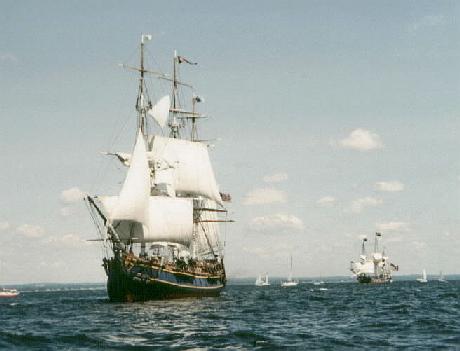 And again, in writing about the voyage of the 'Rembang' conveying the survivors of the 'Pandora' from Coupang to Batavia, he had praise for Capt. Edwards, noting that had he not taken charge of that 'badly found and worse managed' ship, it would have never reached port.
And again, in writing about the voyage of the 'Rembang' conveying the survivors of the 'Pandora' from Coupang to Batavia, he had praise for Capt. Edwards, noting that had he not taken charge of that 'badly found and worse managed' ship, it would have never reached port.
He seems to have been a man of a most unconventional personality. He was a would-be reformer and outspoken critic of the Establishment. Yet, he chose the motto and symbol of the conservative Most Noble Order of the Garter with which to be tattooed. However, he appears to have been a radical indeed, in much the same way as his crewmate, Purcell. On the Bounty, the Pandora, and on other vessels, he was the first to stand up for his rights, and the rights of his crew, a shop-steward before the days of unions and a man before his time. Indeed, had he been born into the intellectual radicalism of the American 1960's, he would have fit in.
Interestingly enough, he was more than a little involved in the mutiny, acting as boatswain for the mutineers. But in many ways, he seems to have seen himself as the chronicler of a historical event, forgetting that he himself was part of it.
Choosing to remain on Tahiti, he and Millward moved in with Poeno, a close friend of his, and a chief of the Matavai district. His stay on Tahiti was certainly one of the more unusual. Through Poeno, he became a close advisor and 'taio' ('of equal authority') to Chief Matte (also known as Tinah and Ohoo) who was well on his way to becoming King Pomare the First, Sovereign of all Tahiti.
 Diary of James Morrison
All the while, however, he not only documented his observations, and took an active and successful part in Tahitian society and politics, he was also preparing to take his circumstances into his own hands. In a considerable feat of naval architecture, he single-handedly designed and built, with the aid of the others, a 30-ton schooner, in which he intended, unbeknownst to the others, to sail to Batavia, and from there to England. Morrison felt that it would be unwise to let the others know of his plans, so he let everyone know that it was intended for excursions around the island and to neighboring Moorea.
Diary of James Morrison
All the while, however, he not only documented his observations, and took an active and successful part in Tahitian society and politics, he was also preparing to take his circumstances into his own hands. In a considerable feat of naval architecture, he single-handedly designed and built, with the aid of the others, a 30-ton schooner, in which he intended, unbeknownst to the others, to sail to Batavia, and from there to England. Morrison felt that it would be unwise to let the others know of his plans, so he let everyone know that it was intended for excursions around the island and to neighboring Moorea.
The 'Resolution', as she was named, was launched on 1 Jul 1790. Morrison's plans, however, were to come to naught. Lack of proper canvas and cordage for sails, few if any navigational instruments, insufficient casks for water storage, and his limited knowledge of navigation convinced him, and others who had by then been taken into his confidence, that the attempt to escape to Batavia was impractical at best.
After his return to England, he was tried, and found guilty by the court, but with the highest recommendation of mercy. He immediately returned to active duty as a Warrant Officer, and served during the heroic period of St. Vincent, the Nile, Copenhagen, and Trafalgar.
His last ship was the 'Blenheim' flagship of Admiral Sir Thomas Troubridge on the East Indies station, based at Penang. He had served on the ship as a young gunner prior to his Bounty experience. When ordered to the Cape for duty, the ship was in no condition to sail. However, the Admiral was anxious to reach his new station, and, accompanied by the 'Harrier' commanded by the son of Admiral Troubridge, sailed from Penang in December of 1906 bound for the Cape via Madras. On 1 Feb 1807, in a frightful gale off the Madagascar coast, the old ship floundered with all hands, including Morrison, the Bounty's own intellectual protestor, serving conscientiously the Establishment he railed against.
Samuel Eliot Morison Historian
Samuel Eliot Morison, son of John H. and Emily Marshall (Eliot) Morison, was born in Boston, Massachusetts, on 9 July 1887. He attended Noble’s School at Boston, and St. Paul’s at Concord, New Hampshire, before entering Harvard University, from which he was graduated with a Bachelor of Arts Degree in 1908. He studied at the Ecole Libre des Sciences Politiques, Paris, France, in 1908-1909, and returned to Harvard for postgraduate work, receiving the degree of Doctor of Philosophy in 1912. Thereafter he became Instructor, first at the University of California in Berkeley, and in 1915 at Harvard. Except for three years (1922-1925) when he was Harmsworth Professor of American History at Oxford, England, and his periods of active duty during both World Wars, he remained continuously at Harvard University as lecturer and professor until his retirement in 1955.
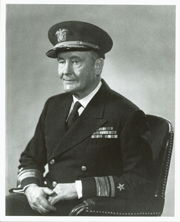
He had World War I service as a private in the US Army, but not overseas. As he had done some preliminary studies on Finland for Colonel House’s Inquiry, he was detailed from the Army in January 1919 and attached to the Russian Division of the American Commission to Negotiate Peace, at Paris, his specialty being Finland and the Baltic States. He served as the American Delegate on the Baltic Commission of the Peace Conference until 17 June 1919, and shortly after returned to the United States. He became a full Professor at Harvard in 1925, and was appointed to the Jonathan Trumbull Chair in 1940. He also taught American History at Johns Hopkins University in 1941-1942.
Living up to his sea-going background – he has sailed in small boats and coastal craft all his life. In 1939-1940, he organized and commanded the Harvard Columbus Expedition which retraced the voyages of Columbus in sailing ships, barkentine Capitana and ketch Mary Otis. After crossing the Atlantic under sail to Spain and back, and examining all the shores visited by Columbus in the Caribbean, he wrote Admiral of the Ocean Sea, an outstanding biography of Columbus, which won a Pulitzer Prize in 1942. He also wrote a shorter biography, Christopher Columbus, Mariner. With Maurico Obregon of Bogota, he surveyed and photographed the shores of the Caribbean by air and published an illustrated book The Caribbean as Columbus Saw It (1964).
Shortly after the United States entered World War II, Dr. Morison proposed to his friend President Roosevelt, to write the operational history of the US Navy from the inside, by taking part in operations and writing them up afterwards. The idea appealed to the President and Secretary of the Navy Frank Knox, and on 5 May 1942, Dr. Morison was commissioned Lieutenant Commander, US Naval Reserve, and was called at once to active duty. He subsequently advanced to the rank of Captain on 15 December 1945. His transfer to the Honorary Retired List of the Naval Reserve became effective on 1 August 1951, when he was promoted to Rear Admiral on the basis of combat awards.
In July-August 1942 he sailed with Commander Destroyer Squadron Thirteen (Captain John B. Heffernan, USN), on USS Buck, flagship, on convoy duty in the Atlantic. In October of that year, on USS Brooklyn with Captain Francis D. Denebrink, he participated in Operation TORCH (Allied landings in North and Northwestern Africa - 8 November 1942). In March 1943, while attached to Pacific Fleet Forces, he visited Noumea, Guadalcanal, Australia, and on Washington made a cruise with Vice Admiral W. A. Lee, Jr., USN. He also patrolled around Papua in motor torpedo boats, made three trips up “the Slot” on Honolulu, flagship of Commander Cruisers, Pacific Fleet (Rear Admiral W.W. Ainsworth, USN), and took part in the Battle of Kolombangara before returning to the mainland. Again in the Pacific War Area in September 1943, he participated in the Gilbert Islands operation on board USS Baltimore, under command of Captain Walter C. Calhoun, USN. For the remainder of the Winter he worked at Pearl Harbor, and in the Spring of 1944, again on board Honolulu, he participated in the Marianas operation before returning to the United States to write.
 In November 1944 he sailed for Europe in the cutter Campbell with Captain W.A.P. Martin, USN, Commander of a convoy escort group. He left Campbell at Gibraltar to visit scenes of recent action in Italy and France, and flew back to the United States in January 1945. In February he joined USS Tennessee, commanded by Captain Heffernan, and flagship of Commander, Gunfire and Covering Force (Rear Admiral Morton L. Deyo, USN). During the amphibious assault upon and subsequent conquest of Okinawa he witnessed many actions under enemy air attack. He later visited Iwo Jima and the Philippines and spent some time working on files in Guam.
In November 1944 he sailed for Europe in the cutter Campbell with Captain W.A.P. Martin, USN, Commander of a convoy escort group. He left Campbell at Gibraltar to visit scenes of recent action in Italy and France, and flew back to the United States in January 1945. In February he joined USS Tennessee, commanded by Captain Heffernan, and flagship of Commander, Gunfire and Covering Force (Rear Admiral Morton L. Deyo, USN). During the amphibious assault upon and subsequent conquest of Okinawa he witnessed many actions under enemy air attack. He later visited Iwo Jima and the Philippines and spent some time working on files in Guam.
In July 1945 he returned again to the United States to work. Released to inactive duty in September 1946, he returned to duty at Harvard, maintaining an office in the Navy Department under the Director of Naval Records and History, to continue his work on the History of United States Naval Operations in World War II. The introduction to the history was written by Commodore Dudley W. Knox, USN, Retired, and in a preface to the first volume, the Secretary of the Navy had made it clear that the author, not the Navy, is responsible for the work. He was assisted from time to time by various Naval Reserve officers and others who had active war service. On 1 March 1963, the International Balzan Foundation announced that Admiral Morison was winner of its cultural prize ($51,750) for his 15-volume history and other maritime research. The 15 historical volumes, published by Little, Brown & Company of Boston, are as follows:
I. The Battle of the Atlantic, September 1939 – May 1943, (1947)
II. Operations in North African Waters, October 1942 – June 1943, (1946)
III. The Rising Sun in the Pacific, 1931 – April 1942, (Bancroft Prize), (1948)
IV. Coral Sea, Midway and Submarine Actions, May 1942 – Aug 1942, (1949)
V. The Struggle for Guadalcanal, August 1942 – February 1943, (1949)
VI. Breaking the Bismarcks Barrier, 22 July 1942 – 1 May 1944, (1950)
VII. Aleutians, Gilberts and Marshalls, June 1942 – April 1944, (1951)
VIII. New Guinea and the Marianas, March 1944 – August 1944, (1953)
IX. Sicily—Salerno—Anzio, January 1943 – June 1944, (1954)
X. The Atlantic Battle Won, May 1943 - May 1945, (1954)
XI. The Invasion of France and Germany, 1944 - 1945, (1955)
XII. Leyte, June 1944 – January 1945, (1956)
XIII. The Liberation of the Philippines, 1944 - 1945, (1959)
XIV. Victory in the Pacific, 1945, (1960)
XV. Supplement and General Index, (1962)
Little, Brown & Company, also published Morison’s Strategy and Compromise in 1958, and The Two Ocean War in 1963, a one-volume history of the US Navy in World War II.
Rear Admiral Morison was awarded the Legion of Merit, with Combat Distinguishing Device “V“, for “exceptionally meritorious conduct in the performance of outstanding services to the Government of the United States as Historian of United States Naval Operations, World War II…” In addition, he received the Victory Medal (World War I); American Campaign Medal; European-African-Middle Eastern Campaign Medal; Asiatic-Pacific Campaign Medal; World War II Victory Medal; and the Philippine Liberation Ribbon; and seven engagement stars on his campaign ribbons. He also was Commander of the Order of the White Rose of Finland. He had the Vuelvo Panamericano Medal, awarded by the Republic of Cuba in 1943; in 1961 he was created Cavaliero Ufficiale of the Italian Order, “Al Merito della Republica;” and in 1963 he was made Commander of the Spanish Order of Isabella the Catholic.
In 1910 he married Miss Elizabeth S. Greene of Boston, Massachusetts, who died on 10 August 1945. Their children were: Elizabeth (wife of Edward D.W. Spingarn, retired Colonel, US Army); Emily (wife of Brooks Beck, former Lieutenant Commander, USNR); Peter Greene Morison (former Lieutenant Commander Royal Navy Volunteer Reserve, later Captain, US Army Air Force); and Catherine. On 29 December 1949 he married Mrs. Priscilla B. Shakelford of Baltimore, Maryland. A grandson, Samuel Loring Morison, served as a US Navy officer off South Vietnam from 1967 to 1968 and in the Naval History Division from 1968-1972.
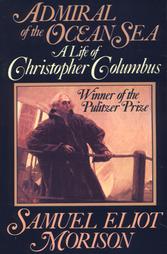 Dr. Morison was author of a number of other works and textbooks, including: Life of Harrison Gray Otis (1913); Maritime History of Massachusetts (1921); Oxford History of the United States (1927); Builders of the Bay Colony (1930); Tercentennial History of Harvard University (awarded Jusserand Medal and Loubat prize, 1930-36); Growth of the American Republic (with Henry Steele Commager) (1937- in its 5th edition, 1962); Portuguese Voyages to America (1940); Admiral of the Ocean Sea (1942) (awarded Pulitzer Prize for biography); Oxford History of the American People (1965); By Land and By Sea (1953); Spring Tides (1965); and “Old Bruin”, A Biography of Commodore Matthew C. Perry (1967). In 1960 he was awarded his second Pulitzer Prize for his biography of John Paul Jones (1959).
Dr. Morison was author of a number of other works and textbooks, including: Life of Harrison Gray Otis (1913); Maritime History of Massachusetts (1921); Oxford History of the United States (1927); Builders of the Bay Colony (1930); Tercentennial History of Harvard University (awarded Jusserand Medal and Loubat prize, 1930-36); Growth of the American Republic (with Henry Steele Commager) (1937- in its 5th edition, 1962); Portuguese Voyages to America (1940); Admiral of the Ocean Sea (1942) (awarded Pulitzer Prize for biography); Oxford History of the American People (1965); By Land and By Sea (1953); Spring Tides (1965); and “Old Bruin”, A Biography of Commodore Matthew C. Perry (1967). In 1960 he was awarded his second Pulitzer Prize for his biography of John Paul Jones (1959).
He was editor of The American Neptune and The New England Quarterly and brought out a new edition of William Bradford’s History of Plymouth Plantation (1952). He was awarded the Emerson-Thoreau Medal of the American Academy of Arts and Sciences and the Gold Medal for history and biography of the National Institute of Arts and Letters. In 1963 he won the Balzan Award for excellence in history, in competition with the historians of the entire world. The ceremony he described in his Vistas of History (1964). He was cited as the foremost authority on US Naval history and a major contributor to American history. Other honors: Past President of the American Historical Association (1950), of the American Antiquarian Society (1938-1950); Vice President of the Naval Historical Foundation, and of the Colonial Society of Massachusetts; Fellow of American Philosophical Society, American Academy of Arts and Sciences, and British Academy; member of the Royal Academy of History, Madrid. He was an honorary member of the Massachusetts Historical Society and the Massachusetts Society of the Cincinnati, and a member of the Charitable Irish Society.
He received honorary degrees from Trinity College, Hartford (1935); Amherst College (1936); Union College (1939); Harvard University (1936); Columbia University (1942); Yale University (1949); Williams College (1950); University of Oxford (1951); Bucknell University (1960); Boston College (1961); and College of the Holy Cross (1962). He was a member of the Army-Navy Club, Washington; Harvard Club, New York; St Botolph Club and Somerset Club, Boston; and Athenaeum, London.
He died on 15 May 1976 of a stroke at Boston, Massachusetts, and his ashes are buried at Northeast Harbor, Maine.
Robert Morison - King's Botanist 1620-1683
MORISON, ROBERT, an eminent botanist of the seventeenth century, was born at Aberdeen in the year 1620. He completed his education in the university of that city, and in 1638 took the degree of Doctor of Philosophy. He was originally designed by his parents for the church, but his own taste led him to the study of botany and physic; and his attachment to those sciences finally prevailing over every other consideration, he began to follow them as a profession. His attachment to the royal cause, induced him to take an active part in the political disturbances of his times. He was present at the battle of the Bridge of Dee, near Aberdeen, and was severely wounded in that engagement. On his recovery, he went to Paris, where he obtained employment as a tutor to the son of counsellor Brizet; but at the same time he zealously devoted himself to the study of botany, anatomy, and zoology.
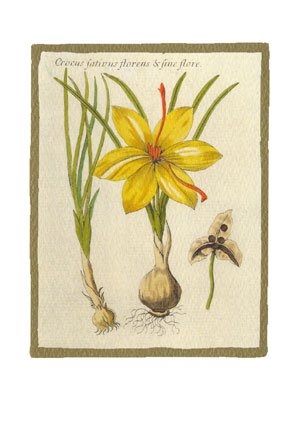 In 1648, he took a doctor’s degree in physic at Angers; and now became so distinguished by his skill in botany, that, on the recommendation of Mr Robin, king’s botanist, he was taken into the patronage of the duke of Orleans, uncle to Louis XIV., and appointed, in 1650, intendant of the ducal gardens at Blois, with a handsome salary. In this situation he remained till the duke’s death, which took place in 1660. While employed in the capacity of intendant, Morison discovered to his patron, the duke of Orleans, the method of botany, which afterwards acquired him so much celebrity. The latter, much pleased with its ingenuity, and the talent which it displayed, afforded its discoverer every encouragement, to prosecute it to completion; and sent him, at his own expense, through various provinces of France, to search for new plants, and to acquire what other information such an excursion might afford. On this occasion, Morison travelled into Burgundy, Lyonnois, Languedoc, and Brittany, carefully investigated their coasts and isles, and returned with many rare, and some new plants, with which he enriched the garden of his patron.
In 1648, he took a doctor’s degree in physic at Angers; and now became so distinguished by his skill in botany, that, on the recommendation of Mr Robin, king’s botanist, he was taken into the patronage of the duke of Orleans, uncle to Louis XIV., and appointed, in 1650, intendant of the ducal gardens at Blois, with a handsome salary. In this situation he remained till the duke’s death, which took place in 1660. While employed in the capacity of intendant, Morison discovered to his patron, the duke of Orleans, the method of botany, which afterwards acquired him so much celebrity. The latter, much pleased with its ingenuity, and the talent which it displayed, afforded its discoverer every encouragement, to prosecute it to completion; and sent him, at his own expense, through various provinces of France, to search for new plants, and to acquire what other information such an excursion might afford. On this occasion, Morison travelled into Burgundy, Lyonnois, Languedoc, and Brittany, carefully investigated their coasts and isles, and returned with many rare, and some new plants, with which he enriched the garden of his patron.
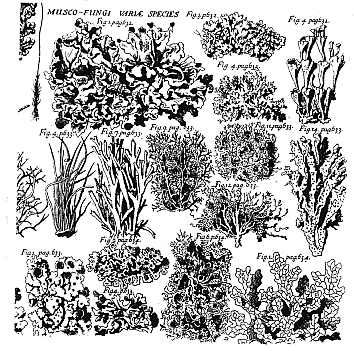 On the death of the duke of Orleans, he was invited to England by Charles II., who had known him while he was in the service of Orleans. His reputation, however, as a botanist, now stood so high, that he was considered as a national acquisition, and was earnestly solicited by Fouquet to remain in France, who, to induce him to comply, made him an offer of a handsome settlement. But love of country prevailed, and he returned to England. On his arrival, Charles bestowed on him the title of king’s physician, and appointed him royal professor of botany, with a salary of £200 per annum, and a free house as superintendent of botany. He was shortly afterwards elected Fellow of the Royal College of Physicians, and daily became more and more celebrated for his knowledge of botany. In the situations to which he was appointed by the king, he remained till 1669, when he was elected, through the interest of the leading men of the university of Oxford, botanic professor of that institution, on the 16th December of the year above named; and on the day following, was incorporated doctor of physic. Here he read his first lecture in the physic school, in September, 1670, and then removed to the physic garden, where he lectured three times a-week to considerable audiences.
On the death of the duke of Orleans, he was invited to England by Charles II., who had known him while he was in the service of Orleans. His reputation, however, as a botanist, now stood so high, that he was considered as a national acquisition, and was earnestly solicited by Fouquet to remain in France, who, to induce him to comply, made him an offer of a handsome settlement. But love of country prevailed, and he returned to England. On his arrival, Charles bestowed on him the title of king’s physician, and appointed him royal professor of botany, with a salary of £200 per annum, and a free house as superintendent of botany. He was shortly afterwards elected Fellow of the Royal College of Physicians, and daily became more and more celebrated for his knowledge of botany. In the situations to which he was appointed by the king, he remained till 1669, when he was elected, through the interest of the leading men of the university of Oxford, botanic professor of that institution, on the 16th December of the year above named; and on the day following, was incorporated doctor of physic. Here he read his first lecture in the physic school, in September, 1670, and then removed to the physic garden, where he lectured three times a-week to considerable audiences.
This appointment he held, occasionally employing himself besides on his great work, Historia Plantarum Oxoniensis, till his death, which took place on the 9th November, 1683, in consequence of an injury which he received from the pole of a carriage, as he was crossing a street. He died on the day following the accident, at his house in Green street, Leicester-fields, and was buried in the church of St Martin’s-in-the-fields, Westminster.
 Morison’s first publication was a work, entitled, "Hortus Regius Blesensis auctus; accessit Index Plantarum in Horto contentarum, nomine Scriptorum et Observationes generaliores, seu Praeludiorum pars prior, London, 1669," 12mo. This work added greatly to his reputation, and was the means of recommending him to the professorship at Oxford. His next publication was, "Plantarum Umbelliferarum Distributio Nova, per tabulas cognationis et afflnitatis, ex libro Naturae observata et delecta, Oxon, 1672," fol. This was given as a specimen of his great work, "Historia Plantarum Universalis Oxoniensis." It attracted the notice of the learned throughout all Europe, and added greatly to his reputation. Encouraged by its reception, he proceeded vigorously with the work which was intended to typify, and produced the first volume, under the title already quoted, in 1680. His death, however, prevented its completion, and left him time to finish nine only of the fifteen classes of his own system.
Morison’s first publication was a work, entitled, "Hortus Regius Blesensis auctus; accessit Index Plantarum in Horto contentarum, nomine Scriptorum et Observationes generaliores, seu Praeludiorum pars prior, London, 1669," 12mo. This work added greatly to his reputation, and was the means of recommending him to the professorship at Oxford. His next publication was, "Plantarum Umbelliferarum Distributio Nova, per tabulas cognationis et afflnitatis, ex libro Naturae observata et delecta, Oxon, 1672," fol. This was given as a specimen of his great work, "Historia Plantarum Universalis Oxoniensis." It attracted the notice of the learned throughout all Europe, and added greatly to his reputation. Encouraged by its reception, he proceeded vigorously with the work which was intended to typify, and produced the first volume, under the title already quoted, in 1680. His death, however, prevented its completion, and left him time to finish nine only of the fifteen classes of his own system.
Philip Morrison - Physicist Los Alamos
Philip Morrison (1915 - 2005) Philip Morrison was born on November 7, 1915, in Somerville, New Jersey. Stricken with polio as a child, a disease that left him partly handicapped, he started tinkering with machinery and was building radios by age 5. He grew up in Pittsburgh and attended Carnegie Institute of Technology (now Carnegie Mellon) and then the University of California, Berkeley, where he obtained a Ph.D. in physics.
 In 1945, Morrison was among the scientists of the Manhattan Project, along with J. Robert Oppenheimer, his former graduate-school teacher, and was witness to the Trinity nuclear testing. He helped assemble the bombs dropped on Hiroshima and Nagasaki, and was part of a team that toured Japan after the country's surrender ended World War II.
In 1945, Morrison was among the scientists of the Manhattan Project, along with J. Robert Oppenheimer, his former graduate-school teacher, and was witness to the Trinity nuclear testing. He helped assemble the bombs dropped on Hiroshima and Nagasaki, and was part of a team that toured Japan after the country's surrender ended World War II.
Following the war, Morrison became a forceful advocate of international arms control, helping to found the Federation of American Scientists, writing for the Bulletin of Atomic Scientists, appearing at meetings and signing statements opposing militarism. His views on disarmament led him to be labeled a communist sympathizer, and he was called to testify before the U.S. Senate International Security Subcommittee in 1953.
 In 1946, Morrison left Los Alamos and jointed Hans Bethe at Cornell, where he became interested in astrophysics and cosmology. During the 1950s, he began to concentrate on theoretical astrophysics, and he and a colleague proposed a search for radio signals emanating from extraterrestrial beings. He moved on to M.I.T. in 1964, where he authored and co-authored several books and studies on arms control. He later became involved in television and film, co-writing and narrating the 1977 film "Powers of Ten," which was later turned into a book, and hosting a six-part PBS miniseries called "The Ring of Truth." Morrison was also a book-review editor for Scientific American magazine.
In 1946, Morrison left Los Alamos and jointed Hans Bethe at Cornell, where he became interested in astrophysics and cosmology. During the 1950s, he began to concentrate on theoretical astrophysics, and he and a colleague proposed a search for radio signals emanating from extraterrestrial beings. He moved on to M.I.T. in 1964, where he authored and co-authored several books and studies on arms control. He later became involved in television and film, co-writing and narrating the 1977 film "Powers of Ten," which was later turned into a book, and hosting a six-part PBS miniseries called "The Ring of Truth." Morrison was also a book-review editor for Scientific American magazine.
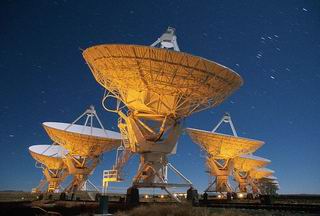 Morrison died April 22, 2005, at his home in Cambridge, Massachusetts, from respiratory failure. He was professor emeritus at M.I.T. and is survived by a stepson.
Morrison died April 22, 2005, at his home in Cambridge, Massachusetts, from respiratory failure. He was professor emeritus at M.I.T. and is survived by a stepson.
Nothing Is Too Wonderful to Be True by Philip Morrison
Related Section The Manhattan Project: Making the Atomic Bomb
Eyewitness Accounts of the Explosion at Trinity on July 16, 1945 by Philip Morrison
Related Sites ALSOS Library on Nuclear Issues Entry: Philip Morrison
Los Alamos National Labs: Staff Biographies: Philip Morrison
Robert Morrison Missionary to China
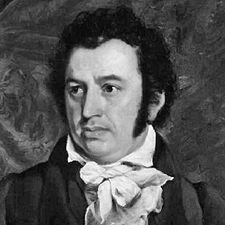 Born January 5, 1782 in Bullers Green, near Morpeth, Northumberland
Born January 5, 1782 in Bullers Green, near Morpeth, NorthumberlandDied August 1, 1834 in Guangzhou
Robert Morrison was a Scottish missionary, the first Christian Protestant missionary in China[1]. After twenty-five years of intense work he translated the whole Bible into the Chinese language and baptized ten Chinese believers. Morrison pioneered the translation of the Bible into Chinese and planned for the distribution of the Scriptures as broadly as possible, unlike the previous Roman Catholic translation work that had never been published. [2] Morrison worked with such contemporary missionaries as Walter Henry Medhurst and William Milne (the printers), Samuel Dyer (Hudson Taylor's father-in-law), Karl Gutzlaff (the Prussian linguist), and Peter Parker (China's first medical missionary).
 He served for 27 years in China with one furlough home to England. The only missionary efforts in China were restricted to Guangzhou (Canton) and Macau at this time. They concentrated on literature distribution among members of the merchant class, gained a few converts, and laid the foundations for more educational and medical work that would significantly impact the culture and history of the most populous nation on earth. However, when Morrison was asked shortly after his arrival in China if he expected to have any spiritual impact on the Chinese, he answered, “No sir, but I expect God will!”
He served for 27 years in China with one furlough home to England. The only missionary efforts in China were restricted to Guangzhou (Canton) and Macau at this time. They concentrated on literature distribution among members of the merchant class, gained a few converts, and laid the foundations for more educational and medical work that would significantly impact the culture and history of the most populous nation on earth. However, when Morrison was asked shortly after his arrival in China if he expected to have any spiritual impact on the Chinese, he answered, “No sir, but I expect God will!”
To learn more about Robert Morrison, click on the following website:
Chronology of Robert Morrison life
Van Morrison Musician
Van Morrison (born August 31, 1945 as George Ivan Morrison) is a singer and songwriter from Belfast, Northern Ireland. He plays a variety of instruments, including the guitar, harmonica, keyboards, and saxophone. Featuring his characteristic growl — a unique mix of throaty folk, blues, Irish, skat, and Celtic influences — Morrison is widely considered one of the most unusual and influential vocalists in the history of rock and roll. Famed critic Greil Marcus has gone so far as to note that "No white man sings like Van Morrison."
 Sometimes dubbed "Van the Man", Morrison first rose to prominence as the lead singer of the Northern Irish band Them, penning their seminal 1965 hit "Gloria". A few years later, Morrison left the band for a successful solo career.
Sometimes dubbed "Van the Man", Morrison first rose to prominence as the lead singer of the Northern Irish band Them, penning their seminal 1965 hit "Gloria". A few years later, Morrison left the band for a successful solo career.
Morrison has pursued an idiosyncratic musical path. Much of his music is tightly structured around the conventions of American soul and R&B, such as the popular singles "Brown Eyed Girl", "Moondance", and "Domino". An equal part of his catalogue consists of lengthy, loosely connected, spiritually inspired musical journeys that show the influence of Celtic tradition, jazz, and stream-of-consciousness narrative, such as his classic album Astral Weeks and lesser known works such as Veedon Fleece. The two strains together are sometimes referred to as "Celtic Soul".
Morrison's career, spanning some four decades, has influenced many popular musical artists. He was inducted into the Rock and Roll Hall of Fame and the Songwriters Hall of Fame. In 2000, Morrison ranked number 25 on American cable music channel VH1's list of its 100 greatest artists of rock and roll. He lives in Belfast, Northern Ireland
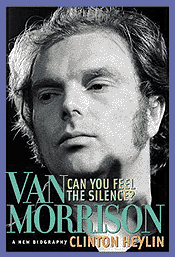 Early life
Early lifeGrowing up in a Church of Ireland family in East Belfast, Morrison was exposed to music from an early age, as his father, George, collected American jazz and blues albums, and his mother Violet was a singer. His father's taste in music was passed on to him, and he grew up listening to artists such as Ray Charles, Leadbelly and Solomon Burke. In a 2005 Rolling Stone article he said that "Those guys were the inspiration that got me going. If it wasn't for that kind of music, I couldn't do what I'm doing now."[1] Before becoming a successful musician, Morrison had a job as a window cleaner, [2] referenced in the autobiographical songs "Cleaning Windows" and "St Dominic's Preview".
1960s
Morrison left home at age 15 to pursue a music career. He played in several local skiffle and rock 'n' roll bands, including playing saxophone for Clubsound during practise sessions, before joining the group The Monarchs and touring across Europe. He formed the group Them in 1964 and came to prominence fronting the band. The band had a number of chart hits, most notably the rock standard, "Gloria", subsequently covered by many artists, including The Doors and Shadows of Knight. At one point in the mid-60's Van also played impromptu in Los Angeles at the Whisky a Go Go club with Jim Morrison, in which the two sang 'Gloria' together. He was quoted, years later during an interview saying, "Of my whole career, the shining moment was when I sang 'Gloria' onstage at the Whisky with Jim Morrison."
Morrison Formation - Land of the Dinosaur
The Morrison formation takes its name from the Town of Morrison, Colorado, where varicolored shales are exposed along the west side of the Dakota Hogback. This strata of rock dates to 150 million years ago durig the Late Jurasic Period. This hogback, known locally as Dinosaur Ridge, was formed when the region was tilted sharply by the uplift of the Front Range of the Rocky Mountains to the west. Beneath the resistant sandstone caprock of the Dakota Group, the pastel-colored shales and sandstones of the Morrison Formation have been protected somewhat from erosion.
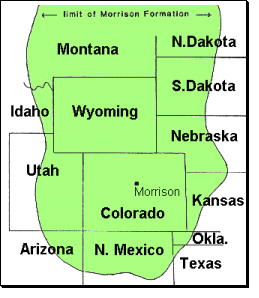 Along the west side of Dinosaur Ridge, the Morrison Formation is 280 to 320 feet thick. The lower parts consist of light gray, greenish gray, and red shales, thin gray limestones, and occasional sandstones. The upper third of the Morrison Formation is made up of interbedded layers of sandstone, siltstone, and red sandy shales. Some geologists consider these rocks part of the Lytle Formation, which they assign to the overlying Dakota Group.
Along the west side of Dinosaur Ridge, the Morrison Formation is 280 to 320 feet thick. The lower parts consist of light gray, greenish gray, and red shales, thin gray limestones, and occasional sandstones. The upper third of the Morrison Formation is made up of interbedded layers of sandstone, siltstone, and red sandy shales. Some geologists consider these rocks part of the Lytle Formation, which they assign to the overlying Dakota Group.
The sediments that comprise the Morrison Formation are believed to have been deposited about 150 million years ago, during Late Jurassic time. They were carried by streams and rivers from ancient highlands (sometimes called the "Ancestral Rockies") far to the west and deposited here in swampy lowland environments.

|
Since its original discovery near Morrison in the late 1800's, the Morrison Formation has been found over a large area of the western states, from the Dakotas to Idaho and Arizona to the panhandles of Texas and Oklahoma (see map at left). Over most of that area, it has yielded a rich trove of dinosaur fossils, beginning with dinosaur discoveries made near Morrison in 1877. Some of the dinosaur bones found here in 1877 are on display at the Morrison Natural History Museum. The dinosaur bones occur in the middle green siltstone beds and in the lower sandstones of the Morrison Formation. The majority of Colorado's known dinosaurs come from the Morrison Formation.
Fred Morrison, Creator of a Popular Flying Plate, Dies at 90
Walter Fredrick Morrison, who at 17 sent the lid of a popcorn tin skimming through the air of a California backyard and as an adult remade the lid in plastic, in the process inventing the simple, elegant flying disc known today as the Frisbee, died Tuesday at his home in Monroe, Utah. He was 90.
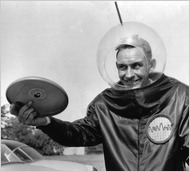
Fred Morrison in 1957 with his disc, then called a Pluto Platter. The cause was cancer, said Phil Kennedy, the author with Mr. Morrison of “Flat Flip Flies Straight: True Origins of the Frisbee”(Wormhole Publishers, 2006).
Beloved of man and dog, the Frisbee has for more than half a century been the signature product of Wham-O, a toy and sporting-goods manufacturer based in Emeryville, Calif. The company has sold more than 200 million of the discs since acquiring the rights to Mr. Morrison’s Pluto Platter, as it was then known, in 1957.
At least since antiquity, mankind has been hurling flat, round objects — or flying discs, as they are known in aficionados’ parlance — aloft. But Mr. Morrison is widely credited as having designed the first commercial flying disc expressly manufactured and marketed as such.
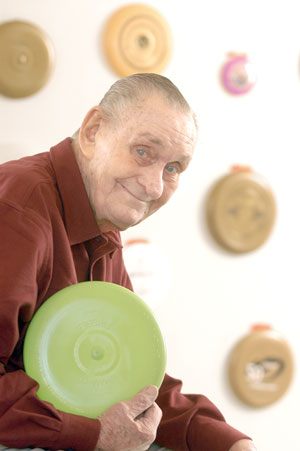 Wham-O changed the name to Frisbee in 1958, influenced by the Frisbie Pie Company in Connecticut, whose tins Yale students hurled for sport. A Westerner whose plainspoken ways could be mistaken for gruffness, Mr. Morrison deplored the change.
Wham-O changed the name to Frisbee in 1958, influenced by the Frisbie Pie Company in Connecticut, whose tins Yale students hurled for sport. A Westerner whose plainspoken ways could be mistaken for gruffness, Mr. Morrison deplored the change.
“I thought the name was a horror,” he told The Press Enterprise of Riverside, Calif., in 2007. “Terrible.” (Before perfecting the Pluto Platter in 1955, Mr. Morrison had called earlier incarnations of his disc the Flyin’ Cake Pan, the Whirlo-Way and the Flyin-Saucer.)
But as his royalties mounted — he would realize millions of dollars over the years — Mr. Morrison revised his position on “Frisbee.”
Walter Fredrick Morrison, known as Fred, was born on Jan. 23, 1920, in Richfield, Utah; he moved with his family to Los Angeles as a teenager.
In 1937, Fred attended a picnic held by the family of his girlfriend, Lucile Nay, known as Lu. Before long, the fateful popcorn lid was thrown. The young couple soon discovered that Fred’s mother’s metal pie tins were far more durable. Mrs. Morrison’s reaction is not recorded.
As they tossed the tin on the beach one day, a passer-by offered to buy it for a quarter. The tin had cost five cents, and soon a thriving resale business was born, with Fred and Lu selling their Flyin’ Cake Pans at Southern California beaches and parks. They earned enough to marry.
In World War II, Mr. Morrison flew P-47 fighter-bombers in Europe, increasing his knowledge of aerodynamics. Returning to Los Angeles after the war, he worked as a carpenter, in his spare time putting his flying disc through successive refinements.
In 1948, he and a partner, Warren Franscioni, manufactured the Flyin-Saucer, the first plastic flying disc. It sold fitfully, and the two men parted company in 1950. The Pluto Platter was Mr. Morrison’s most refined disc. Flat and round, it had a raised central hub, with the names of the planets in raised plastic around the rim. The instructions, molded into the underside, were written by Lu Morrison and read like a Zen koan:
Play catch — Invent Games
To Fly, Flip Away Backhanded
Flat Flip Flies Straight
Tilted Flip Curves — Experiment!
Mr. Morrison was awarded United States patent No. 183,626 for his “Flying Toy” in 1958. In 1967, Ed Headrick Wham-O’s head of research and development, patented alterations to the disc’s shape that improved its aerodynamic ability, resulting in the familiar Frisbee of today.
For Wham-O, Mr. Morrison also invented the Crazy Eight Bowling Ball and the Popsicle Machine, a plastic form that could be filled with juice and frozen. Neither matched the success of the Frisbee, but by then it hardly mattered. In later years, he bred racehorses and flew airplanes.
Mr. Morrison’s marriage to Ms. Nay ended in divorce, as did several later marriages. His survivors include a son, two daughters and grandchildren.
Today, heirs of Mr. Morrison’s flying disc are everywhere, used in backyards worldwide and in organized pastimes like disc golf, a game standardized by Mr. Headrick in which discs are thrown at targets or into baskets, and the team sport known simply as Ultimate, modeled partly on soccer and using a heavy plastic disc.
All this sprang from the Pluto Platter that Mr. Morrison and his wife hawked at midcentury fairgrounds. As it sailed through the air straight and true, Mr. Morrison, a born showman, assured the crowd that his disc was gliding along an invisible wire.
To prove his point, as he recalled in interviews afterward, he offered to sell fairgoers 100 feet of the wire for one dollar. He threw in a Pluto Platter at no extra charge.